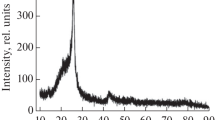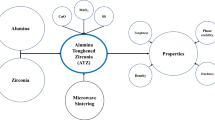Abstract
The effect of two types of additives on the sintering processes of zirconium ceramics was investigated. The impact of both polyvinyl alcohol (12 mass%) and bismuth oxide (1 mass%) on compaction of ultradisperse powders of stabilized zirconia produced by plasma-chemical method and on densification of the compacts during sintering was studied. In the initial state, plasma-chemical powders demonstrate hindered compactibility and sinterability. The additives were incorporated through mechanical stirring with intermediate sieving using a sieve. It was found that introduction of polyvinyl alcohol significantly reduces wall friction and hence facilitates the compaction process. However, no effect on densification and sintering kinetics was observed. Incorporation of bismuth oxide microadditives decreases the temperature of the peak compacting rate. In one-step sintering, the compacts are found to markedly expand at the isothermal ageing stage. The expansion is more distinct at increased compaction pressure. It is shown that this expansion is associated with an increase in the volume of pores surrounded by the liquid phase of bismuth oxide. Two-step sintering with an intermediate stage of isothermal ageing at 1200 °C shows a 100 °C decrease in the sintering temperature, no expansion of the samples occurs at the final ageing stage at sintering temperature, and the ceramics produced exhibits good operational parameters. Recommendations are given on the use of low-melting microadditives in sintering ultradisperse powders obtained by plasma-chemical method.






Similar content being viewed by others
References
Garvie RC, Hannink RH, Pascoe RT. Ceramic steel? Nature. 1975;258:703–4.
Nettleship I, Stevens R. Tetragonal zirconia polycrystal (TZP)—a review. Int J High Technol Ceram. 1987;3:1–32.
Stawarczyk B, Keul C, Eichberger M, Figge D, Edelhoff D, Lümkemann N. Three generations of zirconia: from veneered to monolithic. Part I. J Quintessence Int. 2017;48:369–80.
Tailor S, Singh M, Doub AV. Synthesis and characterization of yttria-stabilized zirconia (YSZ) nano-clusters for thermal barrier coatings (TBCs) applications. J Clust Sci. 2016;27:1097–107.
Freris I, Riello P, Enrichi F, Cristofori D, Benedetti A. Synthesis and optical properties of sub-micron sized rare earth-doped zirconia particles. J Opt Mater. 2011;33:1745–52.
He J, Chen J, Ren L, Wang Y, Teng C, Hong M, Zhao J, Jiang B. Fabrication of monodisperse porous zirconia microspheres and their phosphorylation for Friedel-Crafts alkylation of indoles. J ACS Appl Mater Interfaces. 2014;6:2718–25.
Uchiyama H, Takagi K, Kozuka H. Solvothermal synthesis of size-controlled ZrO2 microspheres via hydrolysis of alkoxides modified with acetylacetone. Colloids Surf A Physicochem Eng Asp. 2012;403:121–8.
Ghyngazov SA, Frangulyan TS. Impact of pressure in static and dynamic pressing of zirconia ultradisperse powders on compact density and compaction efficiency during sintering. Ceram Int. 2017;43:16555–9.
Bortzmeyer D. Dry pressing of ceramic powders. In: Ceramic processing. 1995:102–46.
Rice WR. Hot forming of ceramics. In: Ultrafine-grain ceramics. 1970:203–50.
Chaika ÉV. Isostatic pressing of ceramic articles in thermoplastic molds. Glass Ceram. 2016;73(3–4):91–3.
Papitha R, Suresh MB, Rao YS, Saha BP, Das D, Johnson R. Pressure slip casting and cold isostatic pressing of aluminum titanate green ceramics: a comparative evaluation. Process Appl Ceram. 2013;7(4):159–66.
Lamarre SG, Demers V, Chatelain J-F. Low-pressure powder injection molding using an innovative injection press concept. Int J Adv Manuf Technol. 2017;91(5–8):2595–605.
Li W, Ghazanfari A, Leu MC, Landers RG. Extrusion-on-demand methods for high solids loading ceramic paste in freeform extrusion fabrication. Virtual Phys Prototype. 2017;12(3):193–205.
Schafföner S, Aneziris CG. Pressure slip casting of coarse grain oxide ceramics. Ceram Int. 2012;38(1):417–22.
Gutierrez CA, Moreno R. Influence of slip preparation and casting conditions on aqueous tape casting of Al2O3. Mater Res Bull. 2001;36(11):2059–72.
Junhui X. Study of a novel process-instant solidification of aqueous gel-tape-casting for ceramic sheet formation. Chinese Dissertation of Tsinghua University. Beijing. 2001.
Hotza D, Greil P. Review: aqueous tape casting of ceramic power. Mater Sci Eng A. 1995;202:206–17.
Bakunova NB, Barinov SM, Ievlev VM, Komlev VS, Titov DD. Effect of thermal treatment on sintering and strength of ceramics from hydroxyapatite nanopowders. Inorg Mater Appl Res. 2011;2(4):377–80.
Ivashutenko AS, Frangulyan TS, Ghyngazov SA, Petrova AB. Sintering of zirconia ceramics using microwave and spark heating techniques. In: IOP conference series: mater science and engineering. 2016;110(1). https://doi.org/10.1088/1757-899x/110/1/012105.
Tokita M. Trends in advanced SPS spark plasma sintering systems and technology. J Soc Powder Technol. 1993;30:790–804.
Muccillo ENS, Souza ECC, Muccillo R. Synthesis of reactive neodymia-doped zirconia powders by the sol–gel technique. J Alloys Compd. 2002;344(1–2):175–8.
Trusova EA, Khrushcheva AA, Vokhmintcev KV. Sol-gel synthesis and phase composition of ultrafine ceria-doped zirconia powders for functional ceramics. J Eur Ceram Soc. 2012;32(9):1977–81.
Kuzjukevics A, Linderoth S, Grabis J. Characterization of yttria-doped zirconia powders produced by plasma-chemical method. Solid State Ionics. 1996;92(3–4):253–60.
Flegler AG, Burye TE, Yang Q, Nicholas JD. Cubic yttria stabilized zirconia sintering additive impacts: a comparative study. Ceram Int. 2014;40(PB):16323–35.
Restivo TAG, Durazzo M, de Mello-Castanho SRH, Moreira AC, Graciano S, Telles VB, Tenorio JAS. Low-temperature densification of ceramics and cermets by the intermediary stage activated sintering method. J Therm Anal Calorim. 2017. https://doi.org/10.1007/s10973-017-6560-5.
Li J, Zhang X-H, Cui B-C, Lin Y-H, Deng X-L, Li M, Nan C-W. Mechanical performance of polymer-infiltrated zirconia ceramics. J Dent. 2017;58:60–6.
Surzhikov AP, Frangylyan TS, Ghyngazov SA. A dilatometric study of the effect of pressing on the kinetics of compression of ultrafine zirconium dioxide powders under thermal annealing. Russ Phys J. 2012;55(4):345–52.
Batista RM, Muccillo ENS. Analysis of the sintering process in gadolinia-doped ceria by thermodilatometry and correlation with microstructure evolution. J Therm Anal Calorim. 2018. https://doi.org/10.1007/s10973-018-6969-5.
Łada P, Miazga A, Konopka K, Szafran M. Sintering behavior and thermal expansion of zirconia–titanium composites. J Therm Anal Calorim. 2017. https://doi.org/10.1007/s10973-017-6817-z.
Surzhikov AP, Ghyngazov SA, Frangulyan TS, Vasil’ev IP, Chernyavskii AV. Investigation of sintering behaviour of ZrO2 (Y) ceramic green body by means of non-isothermal dilatometry and thermokinetic analysis. J Therm Anal Calorim. 2017;128:787–94.
Acknowledgements
The research was supported by the Russian Science Foundation Grant No. 17-19-01082.
Author information
Authors and Affiliations
Corresponding author
Rights and permissions
About this article
Cite this article
Ghyngazov, S.A., Shevelev, S.A. Effect of additives on sintering of zirconia ceramics. J Therm Anal Calorim 134, 45–49 (2018). https://doi.org/10.1007/s10973-018-7249-0
Received:
Accepted:
Published:
Issue Date:
DOI: https://doi.org/10.1007/s10973-018-7249-0




